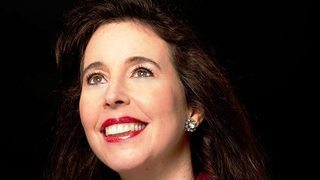|
Back
The Art of Sublime Simplicity New York
Theresa L. Kaufmann Concert Hall, 92nd Street Y
04/04/2017 -
Johann Sebastian Bach: Partitas No. 1 in B-flat Major, BWV 825, No. 2 in C Minor, BWV 826, & No. 4 in D Major, BWV 828 – Sonata in D Minor, BWV 964
Angela Hewitt (Pianist)

A. Hewitt (© Brend Eberle)
“In Bach’s own pieces, he was generally very brisk, but contrived, beside this briskness, to introduce so much variety that each piece was like a discourse.”
Johann Nikolaus Forkel: From 1804 Bach biography
Unfair it may be, but when Angela Hewitt appeared on the large balconied Theresa Kaufmann Auditorium last night, I felt it was the wrong place for the wrong player. And couldn’t help harking back to around 1732, when the all-male merchant clientele of Leipzig’s Zimmermannsche Kaffeehaus would be ushered out–presumably grumbling–because no less a personage than the Organist of the Cathedral, Herr Johann Sebastian Bach, was giving a private concert.
A concert which would include in the audience women!! Almost a scandal. Yet when he sat down, not at his famous organ, but a simple single-manual harpsichord, and started to play dances...well, the invited clientele would be inspired to take a hefty sip from their cups of Ottoman Brew, may have inhaled a stiff puff of savage Indian weed in their Dutch-made pipes and paid extra attention.
For, truth to be told, the three partitas by Herr Bach played by Ms . Hewitt were never meant for the grand concert hall. Not that the composer felt anything but affection for the keyboard pieces (they were his first published works). Yet his own description was hardly how he might describe his St. Matthew Passion. They were “galantries composed for music-lovers, to refresh their spirits.”
Along with that Turkish brew which would be banned by Frederic the Great several decades later.
Ms. Hewitt used her prized bespoke Fazioli piano, not a harpsichord. And while her own father, like Bach, was church organist (in Ottawa), Ms. Hewitt, came here to perform these wondrous “lesser’ works as part of her “Bach Odyssey” series.
The audience relished her playing and for good reason. The two opening partitas of the first half were sensible, safe, and (regretfully) most pleasant.
One cannot fault the pianist’s conservative attitude. I happen to find her more free-wheeling Ravel more interesting, but this is her interpretation of Bach, and she has the technique and good sense to make it come alive.
Not that any more rambunctious performer could inspire the audience to boogie a courante in the 92nd Street Y aisles. (heaven forbid!). But in choosing a point between Pedagogue and Terpsichore. Ms. Hewitt was not afraid to give each movement a restrained lilt.
The tempos were judicious, each section had its own character. We had surprises as well, as Ms. Hewitt danced into the fughetta of the opening Second Partita. Yet in the middle Allemande and Sarabande, Ms. Hewitt had that so professional balance of color and shading. As for the final capriccio, one could imagine a Mozart or Beethoven improvising. Bach, though, even slumming down to the coffee house, would never consider that. Nor did he have to. Ms. Hewitt showed a playfulness which one would rarely associate with Bach himself.
No, this was not a Baroque German coffee house, nor could Ms. Hewitt’s piano replicate the texture of the original keyboard. Yet if one must have a piano, Angela Hewitt has always known that one can steer a middle path between monochromatic harpsichord plucking and percussive Grand Piano passion.
In these first partitas, she rarely used sustaining pedal for her effects, yet she never attempted a Landowska twang. It was simply good piano playing (okay, great piano technique), and one’s own imagination could fill in the Baroque instrument if necessary.
The second half was totally different–and for good reason. In playing Bach’s arrangement of his own solo violin sonata, Ms. Hewitt was never afraid to use that pedal to give glissandi effects, she was fearless in her tempos, and in the Sonata’s final allegro, she came close to bravura playing. In fact, the entire transcription by the composer finally shattered that so sensible playing of the first half. It was hardly Romantic expression, but one knew that Bach would have relished the color and volume of a grand piano.
Nor did she stop at that point. The first two partitas had been impressive intelligent conceptions. The Fourth Partita is in a different class. Twice the duration (the duration of a Beethoven symphony at 30 minutes), with more variations, as if Bach thought those dance movements needed invention and inspiration.
Had Robert Schumann transcribed this work, he probably would have named it Partita Symphonique, and this was the way Angela Hewitt played it. The opening overture was grand and widely-spaced, the middle movements also came near sweeping playing.
I was not the least bit entranced with Ms. Hewitt’s singular Sarabande here with its plainly artificial lengthy pauses. Nowhere else did she take liberties with grace notes or trills, so these lengthy interruptions seemed an affectation. But never mind: the final minuet and gigue–as well as an appropriate single encore (the D Major fugue from Book One’s Well-Tempered Clavier) closed the recital.
It was not ravishing, it was not Trifonov doing Rachmaninoff or Horowitz doing Scriabin. But it was Angela Hewitt playing what she loved with her love. And that, as will be intoned next week at the 92nd Street Y’s Passover service, is more than sufficient.
Harry Rolnick
|